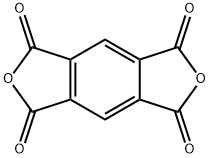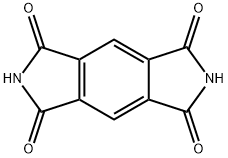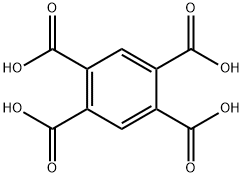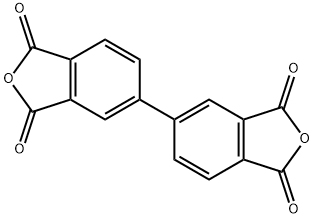Pyromellitic Dianhydride
Synonym(s):1,2,4,5-Benzenetetracarboxylic-1,2:4,5-dianhydride;Benzene-1,2,4,5-tetracarboxylic dianhydride;PMDA;Pyromellitic dianhydride
- CAS NO.:89-32-7
- Empirical Formula: C10H2O6
- Molecular Weight: 218.12
- MDL number: MFCD00005005
- EINECS: 201-898-9
- SAFETY DATA SHEET (SDS)
- Update Date: 2025-01-27 09:38:02

What is Pyromellitic Dianhydride?
Chemical properties
White powder. Soluble in some organic solvents; hydrolyzes to the acid when exposed to moisture.
The Uses of Pyromellitic Dianhydride
Pyromellitic dianhydride (PMDA) is employed as a curing agent for epoxy agent resins used for casting, laminating, the manufacture of moulding powders, adhesives and coatings.
The Uses of Pyromellitic Dianhydride
Pyromellitic dianhydride is used as a monomer in the preparation of polyimide polymers such as kapton; thermoplastics such as polyesters, polyethers, plasticizers, and expoxy resins. It is involved in the preparation of high performance coatings due to its mechanical, thermal and oxidative stability properties. It acts as a curing agent for epoxy resins which find application in adhesives, coatings and molding powders. As an intermediate, it plays an important role in polyimide based materials like printed circuit boards, tape automated bonding and magnetic wire insulation.
What are the applications of Application
Pyromellitic dianhydride is a modifier of the amino group of lysine in proteins
Preparation
Pyromellitic Dianhydride is prepared by gas-phase oxidation of 1,2,4,5-tetramethylbenzene (or related tetrasubstituted benzene derivatives). An idealized equation is:
C6H2(CH3)4 + 6 O2 → C6H2(C2O3)2 + 6 H2O
In the laboratory, it can be prepared by dehydration of pyromellitic acid using acetic anhydride.
What are the applications of Application
Pyromellitic dianhydride (PMDA) has been used extensively as an important monomer in the preparation of a variety of thermoplastics such as polyesters, polycarbonates, polyethers polyethers, plasticizersplasticizers, expoxy resins, etc. Moreover, it is also useful in the preparation of high performance coatings that have been widely employed in many fields in our daily life beacuase of its excellent thermal, oxidative stability and excellent mechanical properties.
Pyromellitic dianhydride (PMDA) is one of several highly reactive acid anhydrides and used extensively in the production of thermoplastics and high-performance coatings. Anhydrides including PMDA are respiratory irritants and immediate-type sensitisers. Some anhydrides have been associated with occupational asthma. PMDA has also been related to occupational asthma.
General Description
Pyromellitic dianhydride (PMDA) is an acidic anhydride that can be used as a repair agent and as a chain extender in the formation of polyethylene terephthalate (PET) based chain extensions. It is mainly used in the production of thermoplastics and other coating applications.
Hazard
Skin irritant.
Flammability and Explosibility
Not classified
Purification Methods
Crystallise the dianhydride from ethyl methyl ketone or dioxane. Dry, and sublime it in vacuo.[Beilstein 19 H 196, 19/5 V 407.]
Properties of Pyromellitic Dianhydride
| Melting point: | 283-286 °C(lit.) |
| Boiling point: | 397-400 °C(lit.) |
| Density | 1,68 g/cm3 |
| vapor pressure | 0Pa at 25℃ |
| refractive index | 1.6000 (estimate) |
| Flash point: | 380 °C |
| solubility | Soluble in dimethyl sulfoxide, acetone, chloroform, ethyl ether, n-hexane and benzene. |
| form | Fine Powder |
| pka | 5.45[at 20 ℃] |
| color | White to pale yellow |
| Water Solubility | decomposes |
| Sensitive | Moisture Sensitive |
| BRN | 213583 |
| CAS DataBase Reference | 89-32-7(CAS DataBase Reference) |
| NIST Chemistry Reference | 1,2,4,5-Benzenetetracarboxylic anhydride(89-32-7) |
| EPA Substance Registry System | 1H,3H-Benzo[1,2-c:4,5-c']difuran-1,3,5,7-tetrone (89-32-7) |
Safety information for Pyromellitic Dianhydride
| Signal word | Danger |
| Pictogram(s) |
 Corrosion Corrosives GHS05  Health Hazard GHS08 |
| GHS Hazard Statements |
H317:Sensitisation, Skin H318:Serious eye damage/eye irritation H334:Sensitisation, respiratory |
| Precautionary Statement Codes |
P261:Avoid breathing dust/fume/gas/mist/vapours/spray. P272:Contaminated work clothing should not be allowed out of the workplace. P280:Wear protective gloves/protective clothing/eye protection/face protection. P284:Wear respiratory protection. P302+P352:IF ON SKIN: wash with plenty of soap and water. P305+P351+P338:IF IN EYES: Rinse cautiously with water for several minutes. Remove contact lenses, if present and easy to do. Continuerinsing. |
Computed Descriptors for Pyromellitic Dianhydride
| InChIKey | ANSXAPJVJOKRDJ-UHFFFAOYSA-N |
Pyromellitic Dianhydride manufacturer
JSK Chemicals
New Products
4,4-Difluoropiperidine hydrochloride tert-butyl 9-methoxy-3-azaspiro[5.5]undecane-3-carboxylate Indole Methyl Resin N-Isopropylurea N,N-Dicyclohexylcarbodiimide(DCC) MELDRUMS ACID 5-METHYLISOXAZOLE-4-CARBOXYLIC ACID Magnessium Bis glycinate Zinc ascorbate 1-bromo-2-butyne 2-acetamidophenol 9(10H)-anthracenone Erythrosin B, 4-Piperidinopiperidine 2-((4-morpholinophenylamino) (methylthio) methylene) malononitrile 2,4-dihydroxybenzaldehyde 3-(4-morpholinophenylamino)-5-amino-1H-pyrazole-4-carbonitrile Methyl 2-methylquinoline-6-carboxylate 2,6-dichloro-4-nitropyridine 4-Bromo-2-chlorobenzonitrile 2-(benzylamino)acetic acid hydrochloride 4-(tert-Butoxycarbonylamino)but- 2-ynoic acid 3,4-dihydro-2H-benzo[b][1,4]dioxepine 1-Phenyl-1-cycloprppanecarboxylicacidRelated products of tetrahydrofuran








You may like
-
 Pyromellitic dianhydride CAS 89-32-7View Details
Pyromellitic dianhydride CAS 89-32-7View Details
89-32-7 -
 Pyromellitic dianhydride, 98% CAS 89-32-7View Details
Pyromellitic dianhydride, 98% CAS 89-32-7View Details
89-32-7 -
 Pyromellitic Dianhydride (purified by sublimation) CAS 89-32-7View Details
Pyromellitic Dianhydride (purified by sublimation) CAS 89-32-7View Details
89-32-7 -
 Pyromellitic dianhydride CAS 89-32-7View Details
Pyromellitic dianhydride CAS 89-32-7View Details
89-32-7 -
 Pyromellitic dianhydride 95.00% CAS 89-32-7View Details
Pyromellitic dianhydride 95.00% CAS 89-32-7View Details
89-32-7 -
 1,2,4,5-Benzenetetracarboxylic-1,2:4,5-dianhydride CAS 89-32-7View Details
1,2,4,5-Benzenetetracarboxylic-1,2:4,5-dianhydride CAS 89-32-7View Details
89-32-7 -
 Pyromellitic dianhydride CAS 89-32-7View Details
Pyromellitic dianhydride CAS 89-32-7View Details
89-32-7 -
 Pyromellitic Dianhydride, For SynthesisView Details
Pyromellitic Dianhydride, For SynthesisView Details
89-32-7
